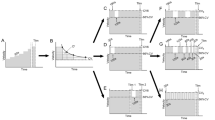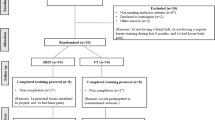Abstract
The purpose of our study was to compare time to exhaustion (tlim) and time spent at a high level of oxygen uptake (V̇O2) during two high-intensity short intermittent exercises (30 s-30 s) realized with or without series. Eleven young endurance-trained athletes [16.6 (0.4) years] took part in three field tests until exhaustion: (1) a maximal graded test to measure their maximal aerobic velocity (MAV) and maximal oxygen uptake (V̇O2max); (2) and (3) two randomized intermittent exercises (30 s at 110% of MAV alternated with 30 s at 50% of MAV): one alternating repetitions non-stop (IE) and another including 4 min recovery every six repetitions (IEs). The mean tlim measured during IEs was significantly longer than IE [respectively 960.0 (102.0) s vs 621.8 (56.2) s]. The time spent at V̇O2max(tV̇O2max) and the time spent above 90% of V̇O2max(t90%V̇O2max) did not differ significantly according to the type of exercise: with or without series [respectively tV̇O2max was 158.2 (59.7) s vs 178.0 (56.5) s and t90%V̇O2max was 290.4 (84.3) s vs 345.0 (61.6) s] but when expressed as a relative value, t90%V̇O2max during IEs was significantly lower than during IE [respectively 36.4 (10.4)% tlim vs 58.3 (8.7)% tlim]. Despite a significant decrease (P<0.005) of time to achieve 90% of V̇O2max at the start of each series during IEs [respectively 165.0 (43.1) s for the first series and 82.5 (15.8) s for the second series (n=6)] the time spent under 90% of V̇O2max limited the t90%V̇O2max during each series. In conclusion, our results showed that intermittent exercise with series does not permit an increase in the time spent at a high level of V̇O2; however, the athletes performed more repetitions of short intense exercise.




Similar content being viewed by others
References
Åstrand I, Astrand PO, Christensen EH, Hedman R (1960) Intermittent muscular work. Acta Physiol Scand 48:448–453
Åstrand PO, Rodahl K (1986) Textbook of work physiology, 3rd edn. McGraw Hill, New York
Ballor DL, Volovsek AJ (1992) Effect of exercise to rest ratio on plasma lactate concentration at work rates above and below maximum oxygen uptake. Eur J Appl Physiol 65:365–369
Barstow TJ (1994) Characterization of V̇O2 kinetics during heavy exercise. Med Sci Sports Exerc 26:1327–1334
Belcastro AN, Bonen A (1975) Lactic acid removal rates during controlled and uncontrolled recovery exercise. J Appl Physiol 39:932–936
Berthoin S, Pelayo P, Lensel-Corbeil G, Robin H, Gerbeaux M (1996) Comparison of maximal aerobic speed as assessed with laboratory and field measurements in moderately trained subjects. Int J Sports Med 17:525–529
Billat VL, Blondel N, Berthoin S (1999) Determination of the velocity associated with the longest time to exhaustion at maximal oxygen uptake. Eur J Appl Physiol 80:159–161
Billat VL, Slawinski J, Bocquet V, Demarle A, Lafitte L, Chassaing P, Koralsztein JP (2000a) Intermittent runs at the velocity associated with maximal oxygen uptake enables subjects to remain at maximal oxygen uptake for a longer time than intense but submaximal runs. Eur J Appl Physiol 81:188–196
Billat VL, Morton RH, Blondel N, Berthoin S, Bocquet V, Koralsztein JP, Barstow TJ (2000b) Oxygen kinetics and modelling of time to exhaustion whilst running at various velocities at maximal oxygen uptake. Eur J Appl Physiol 82:178–187
Billat VL, Slawinksi J, Bocquet V, Chassaing P, Demarle A, Koralsztein JP (2001) Very short (15 s) interval-training around the critical velocity allows middle-aged runners to maintain V̇O2max for 14 minutes. Int J Sports Med 22:201–208
Bogdanis GC, Nevill ME, Lakomy HK, Graham CM, Louis G (1996) Effects of active recovery on power output during repeated maximal sprint cycling. Eur J Appl Physiol 74:461–469
Bogdanis GC, Nevill ME, Lakomy HKA, Boobis LH (1998) Power output and muscle metabolism during and following recovery from 10 and 20 s of maximal sprint exercise in humans. Acta Physiol Scand 163:261–272
Boileau RA, Misner JE, Dykstra GL, Spitzer TA (1983) Blood lactic acid removal during treadmill and bicycle exercise at various intensities. J Sports Med Phys Fitness 23:159–167
Brandon LJ, Boileau RA (1987) The contribution of selected variables to middle and long distance run performance. J Sports Med Phys Fitness 27:157–164
Brooks GA (1985) Anaerobic threshold: review of the concept and directions for future research. Med Sci Sports Exerc 17:22–34
Burnley M, Doust JH, Carter H, Jones AM (2001) Effects of prior exercise and recovery duration on oxygen uptake kinetics during heavy exercise in humans. Exp Physiol 86:417–425
Callier J, Candau R, Magnin P (1994) The effect of induced alkalosis on endurance time during repeated bouts of maximal exercise. Cinésiologie 154:45–50
Dupont G, Blondel N, Lensel G, Berthoin S (2002) Critical velocity and time spent at a high level of V̇O2 for short intermittent runs at supramaximal velocities. Can J Appl Physiol 27:103–115
Dupont G, Blondel N, Berthoin S (2003) Time spent at V̇O2max: a methodological issue. Int J Sports Med 24:291–297
Gerbino A, Ward SA, Whipp BJ (1996) Effects of prior exercise on pulmonary gas-exchange kinetics during high-intensity exercise in humans. J Appl Physiol 80:99–107
Gorostiaga EM, Walter CB, Foster C, Hickson RC (1991) Uniqueness of interval and continuous training at the same maintained exercise intensity. Eur J Appl Physiol 63:101–107
Handschuh R, Rakotoambinina B, Desnus B, Fraisse F (1991) Study of the participation of anaerobic metabolism of the energy requirement according to the duration and intensity of exercise. Sci Sports 6:15–24
Hill DW, Rowell AL (1997) Responses to exercise at the velocity associated with V̇O2max. Med Sci Sports Exerc 29:113–116
Hill DW, Williams CS, Burt SE (1997) Responses to exercise at 92% and 100% of the velocity associated with V̇O2max. Int J Sports Med 18:325–329
Hirvonnen J, Rehumen S, Rusko H, Härkönen M (1987) Breakdown of high-energy phosphate compounds and lactate accumulation during short supramaximal exercise. Eur J Appl Physiol 56:253–259
Jones AM, Wilkerson DP, Burnley M, Koppo K (2003) Prior heavy exercise enhances performance during subsequent perimaximal exercise. Med Sci Sports Exerc 35:2085–2092
Kuipers H, Verstappen FT, Keizer HA, Geurten P, van Kranenburg G (1985) Variability of aerobic performance in the laboratory and its physiologic correlates. Int J Sports Med 6:197–201
Lacour JR, Padilla-Magunacelaya S, Chatard JC, Arsac L, Barthelemy JC (1991) Assessment of running velocity at maximal oxygen uptake. Eur J Appl Physiol 62:77–82
Margaria R, Oliva RD, Di Prampero PE, Cerretelli P (1969) Energy utilization in intermittent exercise of supramaximal intensity. J Appl Physiol 26:752–756
McLaughlin JE, King GA, Howley ET, Bassett DR Jr., Ainsworth BE (2001) Validation of the COSMED K4 b2 portable metabolic system. Int J Sports Med 22:280–284
Messonnier L, Freund H, Denis C, Dormois D, Dufour AB, Lacour JR (2002) Time to exhaustion at V̇O2max is related to the lactate exchange and removal abilities. Int J Sports Med 23:433–438
Millet GP, Candau R, Fattori P, Bignet F, Varray A (2003) V̇O2 responses to different intermittent runs at velocity associated with V̇O2max. Can J Appl Physiol 28:410–423
Noakes TD (1991) Lore of running. Leisure Press, Champaign, p 450
Overend TJ, Paterson DH, Cunningham DA (1992) The effect of interval and continuous training on the aerobic parameters. Can J Sport Sci 17:129–134
Sahlin K, Tonkonogi M, Soderlund K (1998) Energy supply and muscle fatigue in humans. Acta Physiol Scand 162:261–266
Saltin B, Bangsbo J, Graham TE, Johansen L (1992) Metabolism and performance in exhaustive intense exercise: different effects of muscle glycogen availability, previous exercise and muscle acidity. In: Marconnet P, Komi PV, Saltin B, Sejersted OM (eds) Muscle fatigue mechanisms in exercise and training, vol 26. Karger, Basel, pp 98–109
Spangenburg EE, Ward CW, Williams JH (1998) Effects of lactate on force production by mouse EDL muscle: implications for the development of fatigue. Can J Physiol Pharmacol 76:642–648
Taylor H, Buskirk E, Henschel A (1955) Maximal oxygen intake as an objective measure of cardiorespiratory performance. J Appl Physiol 8:73–80
Wenger HA, Bell GJ (1986) The interactions of intensity, frequency and duration of exercise training in altering cardiorespiratory fitness. Sports Med 3:346–356
Whipp BJ (1987) Dynamics of pulmonary gas exchange. Circulation 76:VI18–28
Author information
Authors and Affiliations
Corresponding author
Rights and permissions
About this article
Cite this article
Tardieu-Berger, M., Thevenet, D., Zouhal, H. et al. Effects of active recovery between series on performance during an intermittent exercise model in young endurance athletes. Eur J Appl Physiol 93, 145–152 (2004). https://doi.org/10.1007/s00421-004-1189-z
Accepted:
Published:
Issue Date:
DOI: https://doi.org/10.1007/s00421-004-1189-z




